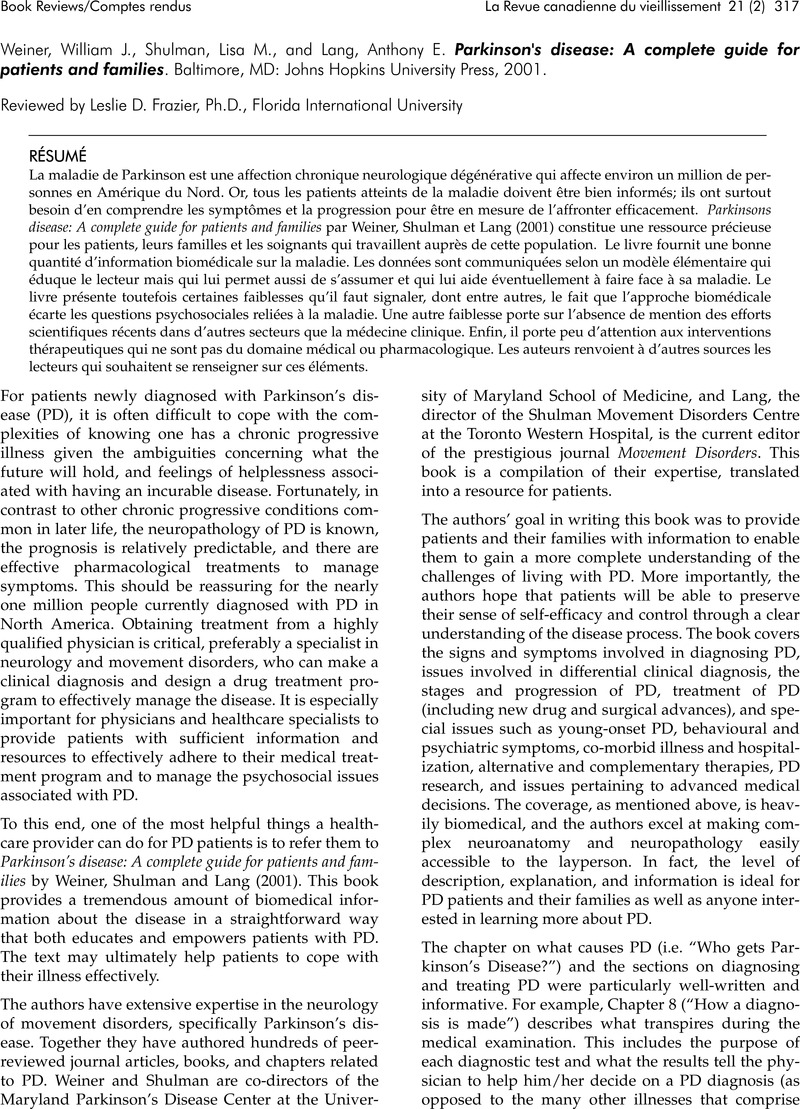No CrossRef data available.
Article contents
William J. Weiner, Lisa M. Shulman, and Anthony E. Lang Parkinson's disease: A complete guide for patients and families. Baltimore, MD: Johns Hopkins University Press, 2001.
Published online by Cambridge University Press: 31 March 2010
Abstract
An abstract is not available for this content so a preview has been provided. Please use the Get access link above for information on how to access this content.

- Type
- Book Reviews/Comptes rendus
- Information
- Canadian Journal on Aging / La Revue canadienne du vieillissement , Volume 21 , Issue 2 , Summer/Été 2002 , pp. 317 - 319
- Copyright
- Copyright © Canadian Association on Gerontology 2002
References
Brod, M., Mendelsohn, G.A., Roberts, B. (1998). Patients' experiences of Parkinson's disease. Journals of Gerontology: Psychological Sciences and Social Sciences, 53, P213–P222.CrossRefGoogle ScholarPubMed
Dakof, G.A., & Mendelsohn, G.A. (1989). Patterns of adaptation to Parkinson's disease. Health Psychology, 8, 355–372.Google Scholar
DeRidder, D., Schreurs, K., & Bensing, J. (2000). The relative benefits of being optimistic: Optimism as a coping resource in multiple sclerosis and Parkinson's disease. British Journal of Health Psychology, 5, 141–155.Google Scholar
Doka, K.J. (1993). Living with life-threatening illness: A guide for patients, their families, and caregivers. San Francisco, CA: Jossey-Bass.Google Scholar
Duvoisin, R.C. (1991). Parkinson's disease: A guide for patient and family. New York: Raven Press.Google Scholar
Engel, G.L. (1977). The need for a new medical model: A challenge for biomedicine. Science, 196, 129–136.CrossRefGoogle Scholar
Ferrucci, L., Baldasseroni, S., Bandinelli, S., De Alfieri, Cartei, A., Calvani, D., Baldini, A., Masotti, G., & Marchonni, N. (2000). Disease severity and health-related quality of life across different chronic conditions. Journal of the American Geriatrics Society, 48, 1490–%1495.CrossRefGoogle ScholarPubMed
Frazier, L.D. (2000). Coping with disease-related stressors in Parkinson's disease. The Gerontologist, 40, 53–63.Google ScholarPubMed
Frazier, L.D. (2001). Stability and change in patterns of coping with Parkinson's disease. Manuscript submitted for publication, Department of Psychology, Florida International University.Google Scholar
Gilbar, O., & Harel, Y. (2000). Adjustment to Parkinson's disease by patients and their spouses. Illness Crisis and Loss, 8, 47–59.Google Scholar
Hooker, K., Manoogian-O'Dell, M., Monahan, D.J., Frazier, L.D., & Shifren, K. (2000). Does type of disease matter? Gender differences among Alzheimer's and Parkinson's disease spouse caregivers. The Gerontologist, 40, 568–573.Google Scholar
Hooker, K., Monahan, D.J., Bowman, S. R., Frazier, L.D., & Shifren, K. (1998). Personality counts for a lot: Predictors of mental and physical health of spouse caregivers in two disease groups. Journals of Gerontology:, 53, P73–P85.CrossRefGoogle ScholarPubMed
Karlsen, K.H., Tandberg, E., Arsland, D., & Larsen, J.P. (2000). Health related quality of life in Parkinson's disease: A prospective longitudinal study. Journal of Neurology, Neurosurgery & Psychiatry, 69, 584–589.Google Scholar
Koplas, P.A., Gans, H.B., Wisely, M.P., Kuchibhatla, M., Cutson, T.M., Gold, D.T., Taylor, C.T., & Schenkman, M. (1999). Quality of life and Parkinson's disease. Journals of Gerontology, 54, M197–M202.Google ScholarPubMed
Matarazzo, J.D. (1994). Health and behavior: The coming together of science and practice in psychology and medicine after a century of benign neglect. Journal of Clinical Psychology in Medical Settings, 1, 7–40.CrossRefGoogle ScholarPubMed
Mendelsohn, G.A., Dakof, G.A., Skaff, M. (1995). Personality change in Parkinson's disease patients: Chronic disease and aging. Journal of Personality, 63, 233–257.CrossRefGoogle Scholar
Schrag, A., Jahanshahi, M., & Quinn, N. (2000). What contributes to quality of life in patients with Parkinson's disease? Journal of Neurology, Neurosurgery and Psychiatry, 69, 308–312.Google Scholar
Schreurs, K.M.G., DeRidder, D.T., & Bensing, J.M. (2000). A one year study of coping, social support, and quality of life in Parkinson's disease. Psychology and Health, 15, 109–121.CrossRefGoogle Scholar
Shifren, K., & Hooker, K. (1995). Stability and change in optimism: A study among spouse caregivers. Experimental Aging Research, 21, 59–76.Google Scholar
Shifren, K., Hooker, K., Wood, P., & Nesselroade, J.R. (1997). Structure and variation of mood in individuals with Parkinson's disease: A dynamic factor analysis. Psychology and Aging, 12, 328–339.Google Scholar
Smith, T.W. & Nicassio, P.M. (1995). Psychological practice: Clinical application of the biopsychosocial model. In Nicassio, P.M. and Smith, T.W. (Eds.), Managing chronic illness: A biopsychosocial perspective (pp. 1–32). Washington, DC: American Psychological Association.Google Scholar




